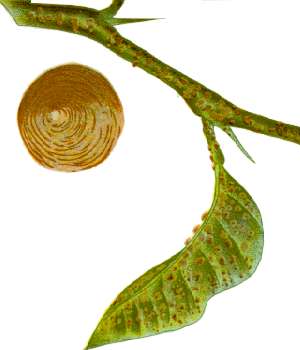
Diaspididae is the largest family of scale insects with over 2650 described species in around 400 genera. As with all scale insects, the female produces a waxy protective scale beneath which it feeds on its host plant. Diaspidid scales are far more substantial than those of most other families, incorporating the exuviae from the first two nymphal instars and sometimes faecal matter and fragments of the host plant. These can be complex and extremely waterproof structures rather resembling a suit of armor. For this reason these insects are commonly referred to as armored scale insects. As it is so robust and firmly attached to the host plant, the scale often persists long after the insect has died.

Diaspidinae is the largest subfamily of Diaspididae, with more than 200 genera in two tribes.

Aspidiotinae is a large subfamily of armored scale insects, with approximately 169 genera.

Ancepaspidinae is a subfamily of armored scale insects in the family Diaspididae. They are found mainly in the New World, although the insects are highly invasive and occur elsewhere.

Aspidiotini is a tribe in the armored scale insect family Diaspididae. They are found worldwide.
Leucaspidini is a tribe of armored scale insects.
Odonaspidini is a tribe in the armored scale insect family Diaspididae.

Parlatoriini is a tribe in the armored scale insect family Diaspididae. Takagi (2002) indicated that the Parlatoriini appear to be phylogenetically related to the Smilacicola and the Odonaspidini. Takagi went on to say about the tropical east Asian Parlatoriini that, The current classification of their genera may be largely tentative because the adult females are simple-featured and much modified owing to the pupillarial mode of life, and also because the second instar nymphs are generally similar among parlatoriines, whether the adult females are pupillarial or not. Andersen found that separating out pupillarial forms into a separate subtribe, Gymnaspidina, was counterproductive, as being non-dispositive.

Aonidiini is a tribe of armored scale insects in the family Diaspididae.
Smilacicola is a genus in the armored scale insect family Diaspididae, the sole genus of the tribe Smilacicolini. There are at least three described species in Smilacicola, found in eastern Asia.

Diaspidini is a tribe in the armored scale insect family Diaspididae. The insects are highly invasive, and are significant economic pests found worldwide.

Lepidosaphidini is a tribe of armored scale insects.

Chionaspidina is a subtribe of armored scale insects established by Borchenius. But unlike many of the subtribes recognized by Borchenius, this one was found to be morphologically valid by Takagi. Similarly, in molecular analysis, Andersen et al. found a clade roughly corresponding to the subtribe Chionaspidina.
Diaspidina is a subtribe of armored scale insects. It occurs mostly in the Americas and Africa, with a few species in tropical Asia. In the Americas Pseudoparlatoria is the largest genus, with Diaspis second; in Africa Diaspis is the largest genus. The grouping identified by Balachowsky in 1954 as the subtribe Diaspidina, are now the tribe Diaspidini.

Fioriniina is a subtribe of armored scale insects in the family Diaspididae. They are found almost exclusively in the Old World.

Chionaspis is a genus of scale insect. In 2011 geographical sampling and analysis indicated a number of unnamed species in the genus Chionaspis.

Fiorinia is a genus of armored scale insects with around 70 species. The species are widely distributed around the world. However, the large majority of them are found in southern Asia. They infest woody plants like forest or crop trees, palm trees and shrubs. Several species are invasive and these are mainly polyphagous species which have spread with the trade of ornamentals. For example, 7 species have been introduced into North America.

Parlatoria is a genus of scales and mealybugs in the family Diaspididae. There are at least 80 described species in Parlatoria.

Diaspidiotus is a genus of armoured scales in the family Diaspididae. There are more than 90 described species in Diaspidiotus, found worldwide.

Furcaspis is a genus in the armored scale insect family Diaspididae, the only genus in the subfamily Furcaspidinae. There are about 30 described species in Furcaspis.













